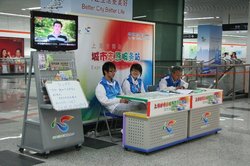 |
| 170,000 volunteers 'man' the stands
in the streets, stations and tourist sites
as well as helping at the Expo |
|
The 2010 World Expo in Shanghai
Open from May 1st to October 31st, the theme is ‘Better City – Better Life’ and you can’t fail to know it
with posters and billboards and 'show
stands' plastered around the city and
surrounding towns, and mascots on sale on
every street.
Newspapers said that the shops had run out
of tickets so to avoid the queues at the
ticket booths you can purchase them from
the Bank of Communication in Nanjing Road
East, about 50 metres from the Bund.
The budget was just under $40 billion –
more than the cost of staging the 2008 Olympics.
As with the Olympics, the renovations and
new infrastructure are breathtaking –
every major street has been repaved, buildings
have had a new lick of paint and 6 new subway
lines have been built. While many of Shanghai’s
colonial-era architectural treasures have
been restored, bulldozers have also razed
whole neighbourhoods so that the city can
look as modern and shiny as possible.
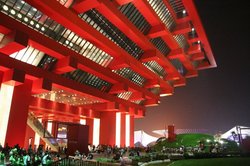 |
| China Pavilion |
|
The China Pavilion was reserved tickets only and practically
impossible to get in to. However, as we lingered
one evening (8.30ish) deciding which of the
restaurants to go to, 2 young girls approached
us and said they were leaving to go home
and they offered us their tickets, which
were for entry between 8.30 and 9.30. So
we rushed over to the pavilion and, to our
surprise, went straight in. Aah, but up a few steps and turn a few corners
and there we were stuck in a people grid
with no return or exit. An hour later we
got in and did a quick trip around the pavilion,
starting on the 12th floor and winding our
way down the building. Was the China
Pavilion worth the long wait in the queue?
No not really - the content wasn't very
inspiring, except for the children’s
art gallery, and the internal tram broke
down so we didn’t see what they had
in store for us to see on that journey. But at least we can say that we are one of
those fortunate enough to see inside the
very grand 12 story temple that dominates
the Shanghai Expo. |
|
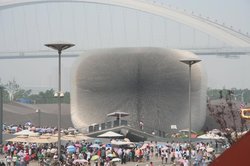 |
| The UK Seed Cathedral |
|
Another stroke of luck got us into the UK pavilion. It was past 9pm and, as we were British
and on our last day, one of the attendants
let us go in the back door. What an awesome
structure and definitely the most innovative
of the show. It’s like a fuzzy cube,
spiked with thousands of floating fibre-optic
‘spines’. Each of the 60,000
fibres let in light from the outside and
each had a unique seed embedded in the end
of the fibre.
The visitor is taken on a journey past a
wall of maps of green and open landscape,
and city lights to the unique ‘fibre-optic’
seed cathedral, then past a ‘plant
river’ before arriving at the open
parkland space where they can sit, relax,
admire the amazing sculpture and marvel at
how such tiny seeds can produce wonders of
nature and life. |
|
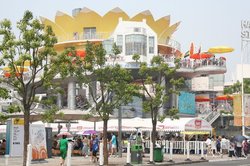 |
| The Netherlands 'Happy Street' |
|
With interesting design and content the Netherlands ‘Happy Street’ pavilion is a 400-meter pedestrian street that curves
in a figure of eight with 26 small houses
(rooms) along the street. The visitor passes
each house peering into each window to see
some art or display of the Dutch culture.
Built completely on stilts, the street
looks like a suspended roller coaster.
SEAC-GM – see the future transportation vehicles
for 2030 in a cinema and show that sees the
cars being driven onto the stage.
Indonesia – some really interesting exhibits
and a coffee bar.
Chile – an impressive steel and wood pavilion
with many interesting displays, although
no Moai or display for Easter Island. However,
don’t forget to try the pisco sour
before you leave!
|
|
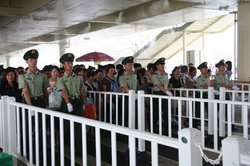 |
| Merching the crowd into the next 'pen' |
|
Queues, Queues and Queues!
The disappointment of the Expo was the queues.
Having travelled over 9000 kilometres to
get there, we were very sad not to see most
of the major pavilions. (perhaps there should
have been a special queue for foreigners,
especially to be admitted into their own
country’s pavilion) The Chinese don't seem to mind
standing in a queue for hours; many take
their own mini, foldup stool to sit on -
5 hours for Saudi Arabia and Japan, 4 hours
for S. Korea and reserved tickets only for
the China and Taiwan pavilions. (Taiwan gives
out 3000 tickets at 9am and 1000 at 6pm but
people queue from noon for the 6pm allocation!).
Most of the queues decrease in the
evening but you can still forget getting
into the UK, USA, Poland, Russia, France,
Germany, Italy, Switzerland, Spain and Canada
unless you want to stand in a queue for hours!
During the peak season the attendance
is averaging over 450,000 visitors a day,
but is that too many to admit or should the
exhibitors cater better for faster throughput?
People shuffle miles up and down the fenced
tracks to get into the pavilions in between
the long periods of just standing on one
spot. If they’re lucky and the queue
is nearly empty they still walk the same
miles but at a greater pace, as the barriers
are not opened to shorten the track!. Where
there are exceptionally long queues, such
as Saudi Arabia, there is an interesting
military method for queue control using ‘people
enclosures'. The army march to the beginning
of the enclosure, remove the barrier and
march the people into the next enclosure
all with exact precision. Then the barrier
is closed and the next crowd is marched
into the empty enclosure. Pushing and shoving
is not allowed! To keep the people cool there
is a spray of water mist that falls from
the ceiling. It was very amusing to watch
but it’s seemed crazy for anyone to
queue for 5 hours in 34 degrees of heat and
humidity for 15 minutes of pleasure! |
|
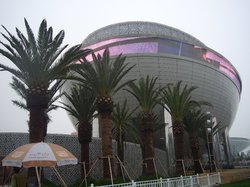 |
| Saudi Arabia |
|
So, what were people queuing to see and what
did I miss because I didn’t want to
queue for hours in the heat to see inside?
Saudi Arabia - has invested about 1.3 billion RMB
to build the world’s largest 3D theatre
with the screen area of 1600 square meters.
Japan - in the shape of “Silkworms”
with three corners to heat and collect rainwater.
Its purple “skin” is made of
glass and recyclable laminated film and the
dome is filled with robots.
Taiwan - the transparent cube is made of steel and
glass, with the outlines of the island's
Mount Morrison and Mount Ali painted on the
facade. The main part of the pavilion was
built with stone from JadeMountain and soil
from Yin-Ko Town and it houses a giant ball
in its centre.
USA - a mammoth gray steel structure meant
to resemble an eagle stretching its wings
in welcome. Visitors can see how a little
girl makes a waste space into a lush garden
in 4D effect.
Spain - the rattan “Big Basket” streamlined
shape has two Flamenco performances daily
and a Spanish restaurant which can accommodate
300 people.
Russia – has constructed its own pavilion
at the exhibition for the first time in 30
years. The 6,000-square-meter sun-shaped
pavilion, dominated by fairy-tale motifs,
comprises 12 white-and-gold towers symbolizing
the 12 months of the year.
Poland - appearing to be a folded paper box, it
is inspired by its folk art of paper cut-outs.
During the daytime, the hall is filled with
light filtering through paper-cutting patterns
and at night, it will shine with different
colors.
Switzerland - featuring the 10 minute chair lift ride
that takes visitors up and out to the roof
garden from the inside pavilion.
Germany - has a metal sensor ball, hanging in the
top of pavilion which moves by voice control.
Denmark – visit the fairy tale kingdom with
the Little Mermaid, shipped over from Copenhagen.
World Meteorological Centre - enjoy the wonders of the world’s
weather with the 4D cinema panorama
that shows how the evolution of the cloud
droplets, fog, typhoons, lightning, and rainbow.
Oil Pavilion – this has the Expo’s only real 4D experience
with an actual 3D film to accompany the water
that it spits in the audience’s face).
The pavilion resembles a huge energy-processing
network with the exterior walls of criss-crossed
petroleum and gas pipes. |
|
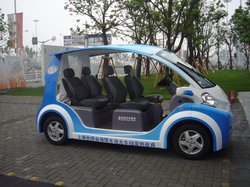 Transport within the Expo is excellent with
all electric free buses and trolley cars.
No liquids are allowed in but water stations
are plentiful for topping up your empty bottles.
Guards, in abundance, are stood to attention
around the expo site to control security
and civic behaviour.
Evening tickets are on sale until 8.50pm
and the Expo is open to midnight but I couldn’t
see the point of that. Some exhibits in the
joint halls closed at 5pm with most major
pavilions allowing last visitors in at 9pm
to close at 10 or 10.30pm. Despite the site
having more than 200 restaurants, (150 in
public areas and 70 run by the Expo pavilions)
they frequently couldn’t provide a
meal past 9.30pm. One KFC could only muster
up some cold fries and another only chicken
burgers. (Infact, one day at 3pm the Bricco
restaurant could only serve a limited range
of pizzas or spaghetti Bolognese as they
had run out of all salads and vegetables).
The metro stops at 11pm so there is a mad
rush to get the last one, but for such a
major event, why weren’t the metro
hours extended? |
|
|
|